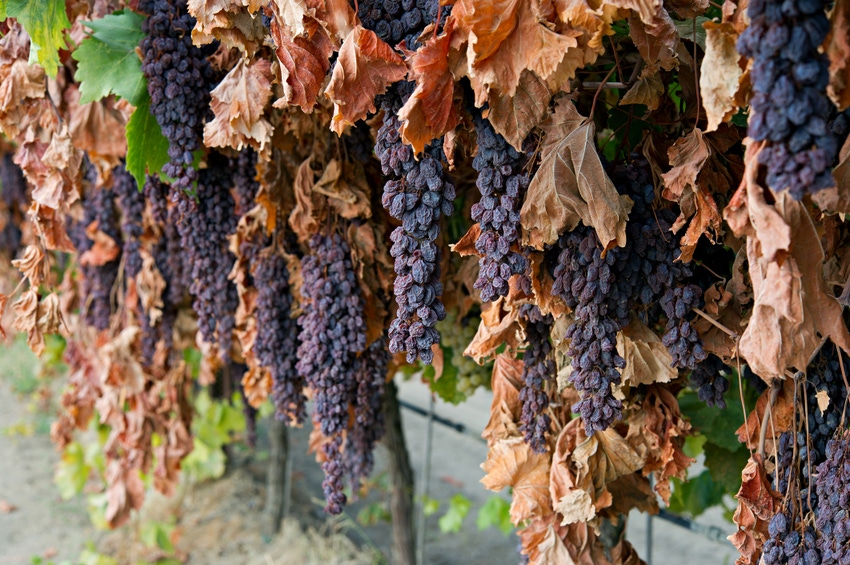
Based on the pace at which sugar levels were developing in the first week of July, this year’s Thompson Seedless raisin harvest, which represents the majority of California’s raisin-type grapes, is likely to get underway in the last week of August.
That’s the assessment by George Zhuang, University of California Cooperative Extension viticulture advisor for Fresno County.
Sugar levels began rising at veraison around mid-June when the berries started softening, he notes. His testing of Thompson Seedless grapes at vineyards in the county on July 5 showed readings had advance to 10 to 11 ºBrix. That puts them on track to reach 20 to 21 ºBrix, the desired level to pick for making raisins, around the end of August.
That’s about the usual time when growers lay the clusters on trays to begin the drying process. The earlier-maturing grape varieties, DOVine Fiesta and Selma Pete, should be ripe enough for growers to begin severing the canes around the beginning of August. The fruit would then dry on the vines for six to eight weeks until ready for machine harvesting, Zhuang adds.
California’s raisin production is centered within about a 60-mile radius of Fresno County. Due to much lower bunch counts, most growers are expecting this year’s crop to be smaller than the historical average.
In June, berries in some raisin vineyards suffered sunburn during nine days in a row of 100-degree-plus temperatures, beginning on the 17th and including four days above 110 degrees, Zhuang notes.
The key to minimizing such injury is keeping the vines well-hydrated.
“Watch the advance weather forecasts carefully,” he says. “If unusually high temperatures are expected in the next week or so, irrigate your vines adequately before then. That can help protect the grapes from severe sunburn.”
Currently, Zhuang is testing the effectiveness of various commercial sunblock products, made with calcium or kaolin and sprayed on the canopies and clusters, in reducing sunburn damage. He expects to have the results of these trials at the end of this season.
Meanwhile, following two seasons of severe pressure from the vine mealybug, the extent of damage to vineyards in the San Joaquin Valley appears to be abating somewhat, Zhuang says.
This insect produces honeydew that serves as a substrate for black sooty mold on clusters and other vine parts. Also, like the grape, obscure and longtailed mealybug, the vine mealybug can transmit the grapevine leafroll viruses.
“Growers are beginning to understand just how serious a threat the vine mealybug is, and that timely insecticide sprays are critical for keeping populations under control,” he says. “Otherwise, vine mealybug numbers can explode quickly and reduce grape yields and quality significantly.”
On Aug. 8, raisin growers will be able to see how a much-talked-about new raisin-type variety, Sunpreme, looks in advance of its first harvest. The two-acre research plot is one of the stops on a tour as part of the University of California Grape Day to be held at the Kearney Agricultural Research and Extension Center near Parlier, Calif., from 7:30 am to noon.
“The Sunpreme vines are in their third leaf,” Zhuang says. “So growers can satisfy their curiosity about how the canopy and yield prospects look with the vines bearing their first crop.”
Sunpreme promises to substantially cut the cost of labor to produce a crop. It was developed to dry naturally on the vine for harvesting with machines, eliminating much of the labor required traditionally to harvest and dry the grapes by hand. What’s more, unlike all other raisin-type grape varieties now grown in California, which are cane-pruned, Sunpreme can be spur-pruned.
“That’s another huge advantage for growers,” Zhuang says. “Spur pruning is much easier to do and requires fewer workers. The ability of Sunpreme to reduce the need for labor represents the future for California’s raisin industry.”
Among other topics to be covered during the free Grape Day event: Nematode problems in grapes, a virtual vineyard, effect of plant growth regulators on Autumn King table grapes, grapevine mineral nutrition and mealybug control.
About the Author(s)
You May Also Like




